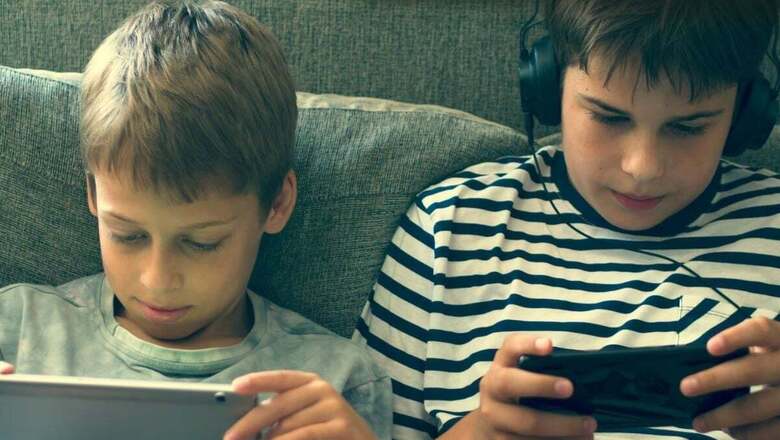
views
As another winter morning begins, the childlike plea of going out to play seems nostalgic rather than the norm, with toys and playgrounds increasingly ceding space to touchscreens and apps. Are fractured attention spans, behavioural changes and depleted social skills the inevitable markers of generations growing up perpetually plugged in?
With average daily screen exposure crossing 5 hours and onset happening before toddlerhood, concerns around the long-term developmental impact on physical, emotional and cognitive dimensions abound. As digital natives immersed in hybrid online-offline realities from birth, will Generation Alpha view the world predominantly through algorithms, not human lenses?
And yet, amidst this sensory overload, glimmers of hope exist by building balance through compassionate solutions. Instead of vilifying technology as adversarial to childhood or human connections, the key lies in recalibrating its role as empowering rather than engulfing. Shifting perspective to view screens as gateways to learning, creativity and bonding opportunities, instead of just productivity suckers brings crucial nuance.
Sandeep Kumar, Founder & Managing Director, Baatu Tech explores the delicate equilibrium between risks and possibilities across key digital domains shaping young minds, alongside tips for parents aiming to nurture digitally savvy yet soulfully enriched children.
Social Media
With a vast majority of teenagers globally on social networks, conversations around skipped heartbeats over likes, anonymous bullying and envy are abundant. As per a study carried out by the American Academy of Paediatrics, excessive preoccupation with social media in children and adolescents has been associated with diverse mental health challenges, encompassing conditions such as depression, anxiety, negative body image, and eating disorders.
Another investigation revealed that over-engagement with social media platforms may result in diminished sleep, insomnia, manifestations of depression, and susceptibility to online harassment. It is crucial to acknowledge, though, that the influence of social media on mental health is contingent upon how it is employed. Notably, social media can serve positively by fostering social connections and facilitating learning experiences.
Therefore, instead of prohibiting access, parents can foster resilience by discussing coping tools to handle fear-of-missing-out (FOMO) syndrome triggered by picture-perfect posts. Initiating open dialogues around self-worth determination builds critical thinking to counter social comparison tendencies.
Guided social media participation with recommended age-wise limits allows children to evolve digital citizenship while avoiding overexposure. Some applications assist by detecting signs of potential cyber-bullying, enabling swift redressal. Simultaneously, emphasizing real-world social connections nurtures emotional wellness.
Tools like text trackers and visual trackers allow for an extra layer of protection and accord peace of mind to parents who can be alerted if their child is engaging in a conversation that may cause long-term impairment.
Video Streaming: Plotting the Middle Path
Unmonitored video streaming risks exposure to age-inappropriate content beyond processing capability. This leads to the propagation of misinformation and in many cases self-injurious behaviour. However, leveraging curated channels with parental controls regulates consumption while retaining edutainment benefits. Enrichment gains maximise when co-viewing facilitates parent-child interactivity through bite-sized content intermingled with conversations connecting observations to real life.
Messaging Apps: Securing Trust, Protecting Privacy
Messaging apps nurture connections but can introduce online risks without safety ground rules. Having open channels for children to highlight unfamiliar contacts and unsafe conversations responsibly is vital for ensuring security. Monitoring tools also secure chats by alerting tone shifts.
Most importantly, building offline trust gives children the confidence to self-report questionable digital experiences. This avoids over-policing their autonomy while securing their journey.
Photos and Videos
Children’s natural creative expression through photos and videos carries a high risk of violations once digitally transmitted. Sensitizing them to the potential dangers of impulsive sharing is effective as opposed to just prohibiting freedoms. Imparting basics of privacy, digital footprints and consent allows intrinsic wisdom to guide online activity as digital natives.
The solution – the real ‘smart’ devices
Managing consumption to recommended limits per age protects child development spanning critical physical activity needs as well as social-emotional learning. Instead of abruptly ending enjoyable sessions, transitional warnings help prepare children for shifts to alternative enrichments like family board games. For parents, screen overlays provide data determining healthy limits specific to their child’s evolving milestones.
Custom child-friendly devices enable parents to monitor their child’s online activities in real-time, by proactively screening usage. These devices avert risks pre-emptively. Some also personalize age-appropriate content suggestions to align with developing interests and maturity.
Furthermore, those equipped with location features allow tracking of outdoor activities too. Such innovations attempt to uphold security without losing trust, via open review mechanisms detailing how children spend screen time.
Such innovations, while granting independence, emphasize safe boundaries, and nurture real-world priorities from family connections to outdoor engagement. The overarching idea is that technology when responsibly harnessed nourishes rather than numbs young minds.
Bottom-line
Going beyond tracking quantitative metrics, using screen time positively means prioritizing consistent quality interactions surrounding device usage for better impact. Are screens enhancing or eclipsing reality? With Awareness not policing as the north star, technology facilitates ease and convenience for young lives.
By infusing compassion alongside consciousness to balance early digital immersion risks, children evolve as empowered netizens. Their future readiness integrates problem-solving skills honed across virtual playgrounds and emotional intelligence nurtured through human connections. Rather than allowing algorithms to exclusively architect childhood experiences, this middle path blends digital possibilities with real-world priorities.













Comments
0 comment